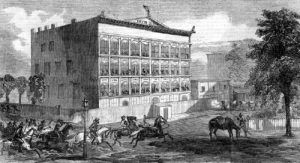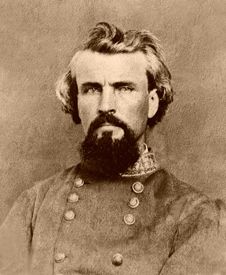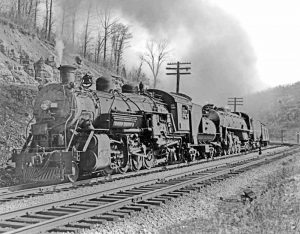In March 1864, Lieutenant-General Ulysses S. Grant, newly named General in Chief of the Armies of the United States, and his most trusted subordinate Major-General William Tecumseh Sherman, planned a new, coordinated strategy to cripple the Confederate States and win the war. While Grant would battle with General Robert E. Lee’s Army of Northern Virginia and head for Richmond, Sherman would try to destroy the Confederate Army of Tennessee. Confederate General Nathan Forrest’s Defense of Mississippi Campaign attempted to stop the Union forces in the south between June and August 1864.
Union Major General A.J. Smith, commanding a combined force of more than 14,000 men, left LaGrange, Tennessee, on July 5, 1864, and advanced south. Smith’s mission was to ensure that Major General Nathan B. Forrest and his cavalry did not raid Major General William T. Sherman’s railroad lifeline in Middle Tennessee and, thereby, prevent supplies from reaching him in his campaign against Atlanta. The first two battles of the campaign were fought in Mississippi at Tupelo and Brice’s Cross Roads. The third and final battle of the campaign was waged at Memphis, Tennessee.
Brice’s Cross Roads (June 10, 1864) – Also called the Battle of Tishomingo Creek, this engagement took place in Prentiss and Union Counties. At the beginning of June 1864, Major General Nathan B. Forrest set out with his cavalry corps of about 2,000 men to enter Middle Tennessee and destroy the Nashville & Chattanooga Railroad, which was carrying men and supplies to Major General William T. Sherman in Georgia. On June 10, 1864, Forrest’s smaller Confederate force defeated a much larger Union column under Brigadier General Samuel Sturgis at Brice’s Cross Roads. This brilliant tactical victory against long odds cemented Forrest’s reputation as one of the foremost mounted infantry war leaders. The Confederate victory resulted in estimated casualties of 2,610 Union and 495 Confederate.
Tupelo (July 14-15, 1864) – Taking place in Lee County, Mississippi, this conflict, also called the Battle of Harrisburg, occurred in defense of the railroad line. Major General A.J. Smith, commanding a combined force of more than 14,000 men, left LaGrange, Tennessee, on July 5, 1864, and advanced south. Smith’s mission was to ensure that Major General Nathan B. Forrest and his cavalry did not raid Major General William T. Sherman’s railroad lifeline in Middle Tennessee and, thereby, prevent supplies from reaching him in his campaign against Atlanta. Laying waste to the countryside as he advanced, Smith reached Pontotoc, Mississippi, on July 11th. Forrest was in nearby Okolona with about 6,000 men, but his commander, Lieutenant General Stephen D. Lee, told him he could not attack until he was reinforced. Two days later, Smith, fearing an ambush, moved east toward Tupelo. On the previous day, Lee arrived near Pontotoc with 2,000 additional men and, under his command, the entire Confederate force engaged Major General A.J. Smith. Within two miles of the Federals, on the night of July 13th, Lee ordered an attack for the next morning. Lee attacked at 7:30 am in several uncoordinated assaults, which the Union troops beat back, causing heavy casualties. Lee halted the fighting after a few hours. Short on rations, Smith did not pursue but started back to Memphis on July 15th. Criticized for not destroying Forrest’s command, Smith had caused much damage and had fulfilled his mission of ensuring Sherman’s supply lines. The Union victory resulted in an estimated 649 Union casualties and 1,300 Confederate.

Confederate Major General Nathan B. Forrest’s raid on Memphis on August 21, 1864, by Harper’s Weekly.
Memphis (August 21, 1864) – At 4:00 am on August 21, 1864, Confederate Major General Nathan Bedford Forrest made a daring raid on Union-held Memphis, Tennessee, occupied by 6,000 Federal troops. The raid was not an attempt to capture the city; rather, it had three other objectives: to capture three Union generals posted there, to release Southern prisoners from Irving Block Prison, and to cause the recall of Union forces from Northern Mississippi. Striking northwestward for Memphis with 2,000 cavalry troops, Forrest lost about a quarter of his strength because of exhausted horses. Surprise was essential. Taking advantage of a thick dawn fog and claiming to be a Union patrol returning with prisoners, the Confederates eliminated the sentries.
Galloping through the streets and exchanging shots with other Union troops, the raiders split to pursue separate missions. One Union general was not at his quarters, and another escaped to Fort Pickering dressed in his nightshirt. Irving Block Prison’s attack also failed when Union troops stalled the State Female College’s main body. After two hours, Forrest decided to withdraw, cutting telegraph wires, taking 500 prisoners and large quantities of supplies, including many horses. Although Forrest failed in Memphis, his raid influenced Union forces to return from northern Mississippi and provide protection. The Confederate victory resulted in an estimated 160 Union casualties and 34 Confederate.
Compiled and edited by Kathy Weiser-Alexander/Legends of America, updated May 2021.
Also See:
Western Theater of the Civil War
Sources:
Battlefields.org
National Park Service Battle Descriptions (no longer available online)
National Park Service Civil War
Wikipedia


